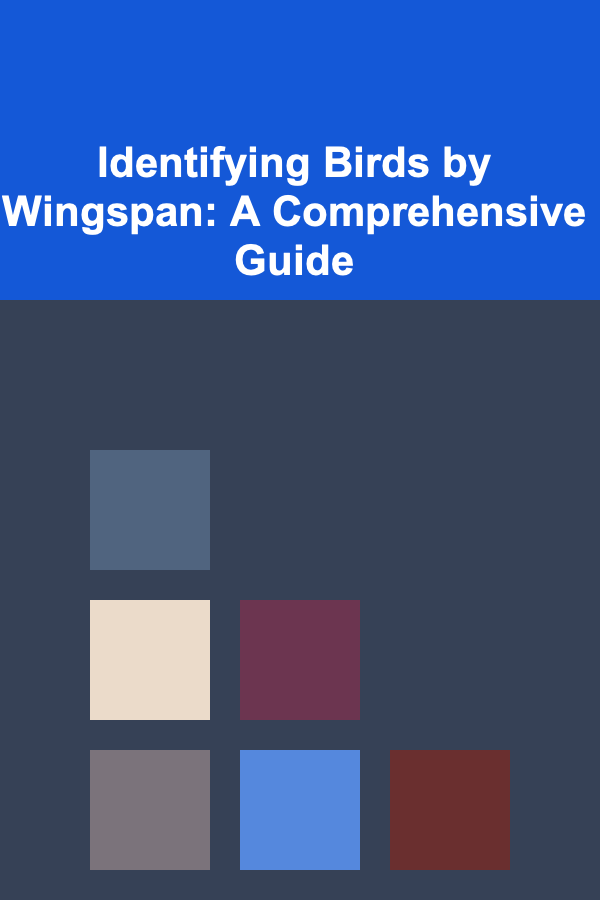
Identifying Birds by Wingspan: A Comprehensive Guide
ebook include PDF & Audio bundle (Micro Guide)
$12.99$10.99
Limited Time Offer! Order within the next:

Bird identification is a fascinating and rewarding pursuit, allowing us to connect with nature and appreciate the diversity of avian life. While many factors contribute to accurate identification, such as plumage, song, behavior, and habitat, wingspan provides a valuable clue, especially when combined with other observational data. This guide delves into the complexities of using wingspan for bird identification, exploring its advantages, limitations, and practical applications.
Understanding Wingspan and Its Significance
Wingspan refers to the distance between the tips of a bird's wings when fully extended. It's a relatively consistent measurement within a species, although slight variations can occur due to factors like age, sex, and individual differences. Wingspan is particularly helpful for identifying birds in flight, where other characteristics might be difficult to discern. It allows for a quick size comparison, narrowing down the possibilities among similar-looking species. However, it's important to remember that wingspan is just one piece of the puzzle, and relying solely on it can lead to misidentification. A comprehensive approach that considers multiple characteristics is crucial.
The Importance of Context
Before diving into specific wingspan measurements, it's crucial to acknowledge the importance of context. Several factors can influence how we perceive a bird's wingspan and how accurate our estimation is:
- Distance: The farther away a bird is, the more difficult it is to accurately judge its size. Perspective can distort our perception, making a distant bird appear smaller than it actually is.
- Lighting: Poor lighting conditions can obscure details and make it challenging to see the full extent of the wings. Backlighting, in particular, can make it difficult to distinguish the wingtips.
- Bird's Posture: Birds rarely fly with their wings fully extended in a perfectly straight line. They may be soaring, gliding, or flapping, each of which can affect the apparent wingspan. Also, birds often fold their wings partially even while soaring, impacting visual estimations.
- Observer Experience: Experienced birders develop a better sense of scale and can more accurately estimate wingspan based on visual cues. Practice and familiarity with local bird species significantly improve estimation accuracy.
- Comparison Points: Having known reference points in the field, like trees, buildings, or even other birds of known size, can aid in relative size comparisons. This is especially useful when trying to distinguish between similar-sized species.
Wingspan as a Diagnostic Tool: Advantages and Limitations
Using wingspan for bird identification offers several advantages:
- Size Categorization: It allows for quick categorization of birds based on size (e.g., small, medium, large, very large). This immediately narrows down the potential species.
- Distinguishing Similar Species: In some cases, wingspan is a key differentiating factor between similar-looking species with overlapping plumage. For example, differentiating between certain hawk species often relies on wingspan measurements.
- Identifying Birds in Flight: When a bird is in flight, plumage details might be obscured, but wingspan remains a relatively consistent and observable feature.
- Supporting Other Observations: Wingspan measurements can corroborate other identification clues, such as habitat, behavior, and call, strengthening the overall identification.
However, it's crucial to acknowledge the limitations of relying solely on wingspan:
- Overlapping Ranges: Many species have overlapping wingspan ranges, making it impossible to definitively identify a bird based on wingspan alone.
- Estimation Errors: Estimating wingspan visually is prone to error, especially for inexperienced observers or under challenging viewing conditions.
- Individual Variation: As mentioned earlier, slight variations in wingspan can occur within a species due to age, sex, and individual genetics.
- Lack of Precise Measurement in the Field: Unless you're handling a bird for research purposes, you won't have a precise wingspan measurement in the field. You'll be relying on estimation and comparison.
- Difficulties in Certain Habitats: In dense forests or cluttered environments, observing the full wingspan of a bird can be difficult or impossible.
Wingspan Categories and Examples
To illustrate how wingspan can be used for bird identification, we can categorize birds into size classes based on their wingspan. These are broad categories, and there will be overlap between them.
Small Birds (Wingspan: Under 10 Inches)
Birds in this category are typically songbirds or small insectivores.
- Ruby-crowned Kinglet (Regulus calendula): Wingspan of approximately 6-7 inches. Often seen flitting through trees and shrubs, gleaning insects.
- Bushtit (Psaltriparus minimus): Wingspan around 6 inches. Social birds that forage in flocks, building distinctive hanging nests.
- Hummingbirds (Various Species): Wingspans ranging from 3 to 5 inches, depending on the species. Known for their incredible hovering ability and vibrant colors.
Medium-Small Birds (Wingspan: 10-15 Inches)
This category includes a variety of songbirds, small woodpeckers, and some shorebirds.
- American Robin (Turdus migratorius): Wingspan of approximately 12-16 inches. A common sight in gardens and parks, known for their reddish-orange breast.
- Downy Woodpecker (Dryobates pubescens): Wingspan of around 10-12 inches. The smallest woodpecker in North America, often seen on tree trunks and branches.
- Killdeer (Charadrius vociferus): Wingspan of approximately 14-15 inches. Shorebirds that often nest in open fields and parking lots, known for their distinctive broken-wing display.
Medium Birds (Wingspan: 15-25 Inches)
This category includes larger songbirds, pigeons, some hawks, and gulls.
- American Crow (Corvus brachyrhynchos): Wingspan of approximately 33-39 inches. Highly intelligent and adaptable birds, often seen in flocks.
- Mourning Dove (Zenaida macroura): Wingspan of around 17-19 inches. A slender dove with a mournful cooing call.
- Northern Flicker (Colaptes auratus): Wingspan of around 16-20 inches. A large woodpecker often seen on the ground foraging for ants.
Medium-Large Birds (Wingspan: 25-40 Inches)
This category includes many raptors (hawks, eagles, falcons), larger gulls, and some waterfowl.
- Red-tailed Hawk (Buteo jamaicensis): Wingspan of approximately 44-52 inches. A common and widespread hawk, often seen soaring over open fields and forests. The 'red tail' is not always visible, however.
- Canada Goose (Branta canadensis): Wingspan of approximately 43-65 inches. Large waterfowl that form strong family bonds and migrate in V-shaped formations.
- Osprey (Pandion haliaetus): Wingspan of approximately 59-72 inches. A fish-eating raptor, often seen near bodies of water, with a distinctive white head.
Large Birds (Wingspan: 40-70 Inches)
This category includes eagles, large vultures, and some larger waterfowl.
- Bald Eagle (Haliaeetus leucocephalus): Wingspan of approximately 72-90 inches. A majestic raptor, the national bird of the United States, often seen near large bodies of water.
- Turkey Vulture (Cathartes aura): Wingspan of approximately 63-72 inches. A scavenging bird with a distinctive reddish-brown head, often seen soaring in circles.
- Great Blue Heron (Ardea herodias): Wingspan of approximately 66-79 inches. A tall wading bird, often seen in marshes and along shorelines.
Very Large Birds (Wingspan: Over 70 Inches)
This category includes albatrosses, condors, and some very large eagles and vultures. These are less common in many areas.
- California Condor (Gymnogyps californianus): Wingspan of approximately 102-113 inches. A critically endangered scavenger, one of the largest flying birds in North America.
- Wandering Albatross (Diomedea exulans): Wingspan of approximately 114-138 inches. This seabird has the largest wingspan of any living bird.
These are just a few examples, and many other species could be included in each category. It's essential to consult field guides and online resources for accurate wingspan measurements and other identifying characteristics of birds in your region.
Practical Techniques for Estimating Wingspan in the Field
While precise measurements are not possible in the field, several techniques can help you estimate wingspan more accurately:
- Familiarize Yourself with Common Birds: Spend time observing common birds in your area and learn their approximate sizes. This will provide a mental reference point for comparing the size of unfamiliar birds.
- Use Known Objects for Comparison: Compare the bird's wingspan to known objects in the environment, such as trees, buildings, or power lines. Estimate the height of the object and then compare it to the bird's wingspan.
- Consider the Bird's Body Length: Estimate the bird's body length and then compare it to its wingspan. In general, birds with longer bodies tend to have proportionally longer wingspans.
- Practice with Photos and Videos: Practice estimating wingspan using photos and videos of birds. Compare your estimates to the actual wingspan measurements to improve your accuracy.
- Observe Multiple Individuals: If possible, observe multiple individuals of the same species. This will help you account for individual variation and get a better sense of the average wingspan.
- Use Binoculars: Using binoculars can help you get a closer look at the bird and make more accurate estimations of its wingspan. Also, look for the shape of the wings and the way the bird flies.
- Document Your Observations: Take notes on your observations, including your estimated wingspan, as well as other identifying characteristics. This will help you track your progress and improve your identification skills over time. Consider using a notebook or a birding app on your smartphone.
Beyond Wingspan: Integrating Other Identification Clues
As emphasized throughout this guide, wingspan is most effective when used in conjunction with other identification clues. Consider the following factors when identifying birds:
- Plumage: Observe the color and pattern of the bird's feathers. Note any distinctive markings, such as wing bars, eye stripes, or breast patterns.
- Shape and Size: Pay attention to the bird's overall shape and size, including its beak shape, leg length, and tail length.
- Behavior: Observe the bird's behavior, such as its foraging habits, flight patterns, and social interactions.
- Habitat: Note the type of habitat where you observe the bird, such as forests, grasslands, wetlands, or urban areas.
- Song and Calls: Listen to the bird's song and calls. Many species have distinctive vocalizations that can aid in identification.
- Range: Be aware of the geographic range of different bird species. This can help you narrow down the possibilities based on your location.
By combining these clues with wingspan measurements, you can significantly increase your chances of accurately identifying birds.
Example: You observe a large bird soaring overhead. It appears to be a raptor with a wingspan of approximately 50 inches. The bird has a brown body, a pale head, and a dark band across its belly. Based on these characteristics, you can tentatively identify it as a Ferruginous Hawk (Buteo regalis), particularly if you are in its typical habitat of open grasslands in the western United States. However, you should confirm this identification by considering other factors, such as its call and specific location within its range.
Resources for Further Learning
Numerous resources are available to help you learn more about bird identification and wingspan measurements:
- Field Guides: Invest in a good field guide for your region. These guides typically include detailed descriptions, illustrations, and range maps for various bird species.
- Online Resources: Many websites and apps offer information on bird identification, including wingspan measurements, photos, and audio recordings. Some popular sites include:
- All About Birds (Cornell Lab of Ornithology)
- Audubon Bird Guide
- eBird
- Birding Organizations: Join a local birding organization. These organizations often offer field trips, workshops, and other educational opportunities.
- Experienced Birders: Learn from experienced birders. Go on birding trips with them and ask questions. Their knowledge and experience can be invaluable.
Conclusion
Identifying birds by wingspan is a valuable skill that can enhance your appreciation of avian diversity. While wingspan alone is rarely sufficient for definitive identification, it provides a crucial piece of the puzzle when combined with other observational data. By understanding the advantages and limitations of using wingspan, practicing your estimation techniques, and integrating other identification clues, you can become a more confident and skilled birdwatcher. Remember that consistent practice and a keen eye for detail are key to mastering the art of bird identification. Happy birding!

How to Plan Seasonal Fitness Area Updates
Read More
How to Set Up a DIY Photo Booth for Your Home Party
Read More
Step-by-Step Tips for Lowering Car Lease Payments Through Negotiation
Read More
How to Develop AI for Creative Arts
Read More
How To Play the Cello: Bowing and Fingering
Read More
How to Handle Data Security and Privacy as a Data Science Consultant
Read MoreOther Products

How to Plan Seasonal Fitness Area Updates
Read More
How to Set Up a DIY Photo Booth for Your Home Party
Read More
Step-by-Step Tips for Lowering Car Lease Payments Through Negotiation
Read More
How to Develop AI for Creative Arts
Read More
How To Play the Cello: Bowing and Fingering
Read More